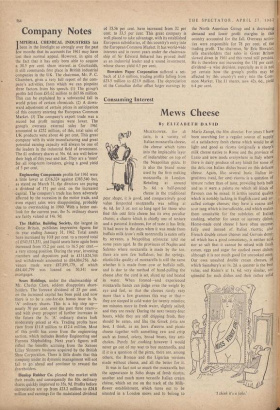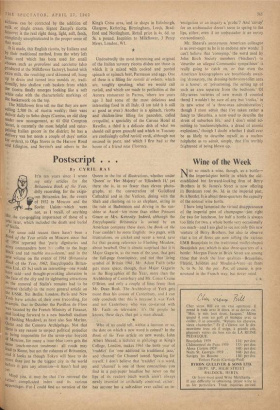Consuming Interest
Mews Cheese
By ELIZABETH DAVID
MILK FLOWER, fiat di lane, is a variety of Italian mozzarella cheese, the cheese which turns into the implacable layer of indiarubber on top of the Neapolitan pizza. It is also the brand name used by the firm making mozzarella in London.
Retailing at around 3s. 6d. a half-pound cheese in the traditional pear shape, it is good, and comparatively good value (imported mozzarella was selling at 4s. 6d. for 3 oz. not so long ago) for those who find this odd little cheese has its owu peculiar charm; a charm Which is chiefly one of texture and a pastoral freshness, for of taste it has little. It had more in the days when it was made from buffalo milk (cow's milk mozzarella is eaten only by servants, a Neapolitan aristocrat told me some years ago). In the provinces of Naples and Salerno where mozzarella is made by the ton, there are now few buffaloes; but the springy, elastic-like quality of mozzarella is still the same whether it is made from cow or buffalo milk, and is due to the method of hand-pulling the cheese after the curd is set, sliced, up and heated in water. When formed-and experienced mozzarella hands can judge even the weight by eye and feel, so that the cheeses rarely vary more than a few grammes this way or that- they are steeped in cold water for twenty minutes; ten minutes more in fresh water, slightly salted; and they are ready. During the next twenty-four hours, while they are still dripping fresh, they should be eaten, and like the Greek fetta are best, I think, as an hors d'ceuvre and picnic cheese together with something raw and crisp such as fennel, celery, broad beans, tiny arti- chokes. Purely for ,cooking however I would never go out of my way to buy mozzarella, and if it is a question of the pizza, there are, among others, the Roman and the Ligurian versions made without cheese, and all the better for it.
It was in fact not so much the mozzarella but the appearance in Soho shops of fresh ricotta, another and much more versatile Italian cream cheese, which set me on the track of the Milk- flower establishment, which turns out to be situated in a London mews and to belong to
Mario Zampi, the film director. For years I hal been searching for a regular source of supp of a satisfactory fresh cheese which would be light and good as ricotta (originally a sheep milk cheese native to Rome and the province Lazio and now made everywhere in Italy whet there is dairy produce of any kind) for some the delicious Italian dishes based on this delica cheese. Again, like several basic Italian it gredients (veal, for one) ricotta is a question texture rather than of taste, providing both bul and as it were a palette on which all kinds flavours can be mixed. It isnhis neutral quali' which is notably lacking in English curd and s( called cottage cheeses; they have a coarse an sour tang which is ineradicable, and which make them unsuitable for the subtleties of Italia cooking, whether for sweet or savoury dishe Home-made curd cheese I have often succes fully used instead of Italian ricotta; als French double cream cheeses and Gervais dem sel which has a good consistency, ,is neither aci nor so salt that it cannot be mixed with fres cream, eggs and sugar for cooked sweet dishe although it is not much good for uncooked one Our own unsalted double cream cheeses, ( which Sainsbury's at Is. 2d. a quarter is the be value, and Raine's at 1 s. 6d. very similar, at splendid for such dishes and their rather soli
re
ly re to )f Ly
�• s.
0
5, s.
it
d
iness can be corrected by the addition of k or single cream. Signor Zampi's ricotta Never is the real right thing, light, soft, fresh, npletely unsophisticated in the proper sense of t word.
It is made, this English ricotta, by Italians and their traditional method, from the whey left curd which has been used for small !eses such as provolone and cacciotto (also iduced at the Milkflower factory), heated with, ra milk, the resulting curd skimmed off, hung to drain and turned into moulds or, tradi- aally, into shallow rush baskets from which ricotta finally emerges looking like a soft ite cake with the characteristic markings of basketwork on the top.
The Milkflower firm tell me that they are now ling 2,500 lb. of ricotta weekly; their vans iver daily to Soho shops (Camisa, an old shop der new management, at 61 Old Compton eet, is currently the most helpful and enter- sing Italian grocer in the district; he has a ivery van but needs a couple of days' notice orders), to Olga Stores in the Harrow Road 1 Islington, and Servini's and others in the tie till ho cot tha by fro ch Prc exi up do the vvh the Sc!] del un Str Art del fur an King's Cross area, and to shops in Edinburgh, Glasgow, Kettering, Birmingham, Leeds, Brad- ford and Nottingham, Retail price is 4s. 6d. to Ss. a pound. Inquiries to Milkflower, 3 Percy Mews, London, WI.
Undoubtedly the most interesting and original of the Italian savoury ricotta dishes are those in which it is mixed with cooked and puréed spinach or spinach beet, Parmesan and eggs. One of these is a filling for tortelli di erbette, which ate, roughly speaking, what we would call ravioli, and which are made to perfection at the Aurora restaurant in Parma, where ten years ago I had some of the most delicious and interesting food in all Italy. (1 am told it is still az good as ever.) Another is a spinach, ricotta and chicken-liver filling for pancakes, called crespolini, a speciality of the Caruso Hotel at Ravello; a third is a delicate dish of what we should call green gnocchi and which in Tuscany are confusingly called ravioli verdi, although not encased in• paste, and which I first had at the house of a friend near Florence. vestigation or an inquiry a, 'probe.? And 'envoy' for an ambassador doesn't seem to spring to the lips, either; even if an ambassador is an envoy extraordinary).
Mr. Sheard's anonymous American colleague is as over-eager as he is to endorse new words: I can't believe that 'comsymp,' the word used by John Birch Society members (`birchers) to `describe an alleged Communist sympathiser' is really going to catch on, or that even the American lexicographers are breathlessly await- ing `dressitory, the dressing-bathroom-toilet area in a house'; or 'privazoning, the setting up of such an area separate from the bedroom.' Of fifty-seven varieties of new words (1 counted them) I wouldn't be sure of any but 'troika,' in its new sense of 'a three-man administration'; though I must admit that I've taken rather a fancy to `distprbia, a term used to describe the stress of suburban life,' and I don't mind ad- mitting to `nucleomitphobia, a dread of atomic explosions,' though I doubt whether I shall ever be as likely , to describe myself, as a nude°. mitphobe as to admit, simply, that I'm terribly frightened of being blown up.















































 Previous page
Previous page